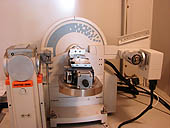X-Ray diffraction (XRD)
Supervisor: M. Sc. Jorrit Bredow
In X-Ray diffraction, polycrystalline bulk samples and epitaxial thin films will be analyzed with a PHILIPS X'pert diffractometer.
As the wavelength of the employed copper X-rays fits the interatomic distances of solid state samples of a few Ångstroms very well, periodic arrays of atoms in crystal lattices are highly suitable for X-ray scattering experiments. Therefore, X-ray diffraction is widely used for structural analysis in research and industry. A highlight of the XRD method is the extremely high precision in determination of various lattice parameters.  An introduction is given on generation and the safety measures for X-rays. The emitted characteristic X-ray lines are correlated to the electronic structure of the atoms of the anode material. Quantum mechanical phenomena such as spin-orbit coupling are directly accessible in the diffraction patterns. Furthermore, the understanding of basic terms of crystallography such as crystal and axis systems, Miller's indices, and practical viewpoints such as the accuracy of goniometer measurements are aims of this experiment.
An introduction is given on generation and the safety measures for X-rays. The emitted characteristic X-ray lines are correlated to the electronic structure of the atoms of the anode material. Quantum mechanical phenomena such as spin-orbit coupling are directly accessible in the diffraction patterns. Furthermore, the understanding of basic terms of crystallography such as crystal and axis systems, Miller's indices, and practical viewpoints such as the accuracy of goniometer measurements are aims of this experiment.
The main tasks are:
Determination of the lattice constants of polycrystalline materials with cubic and hexagonal structure, the analysis of heteroepitaxial ZnO thin films grown on single-cystalline sapphire of various crystallographic orientation, and the preparation and phase analysis of an unknown powder sample.


